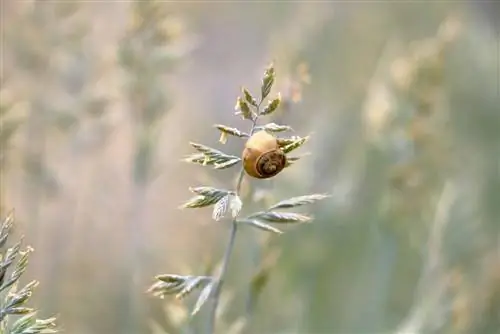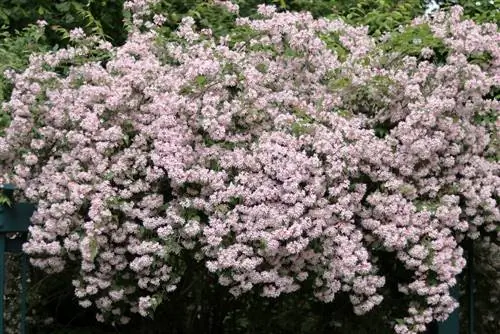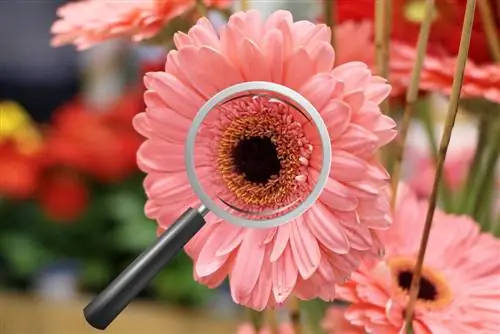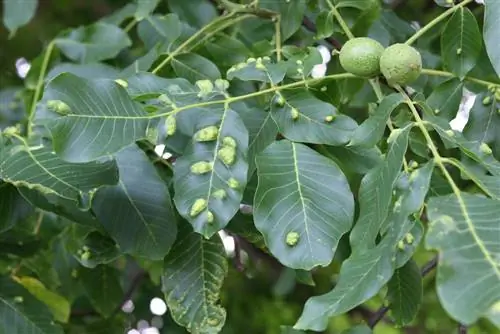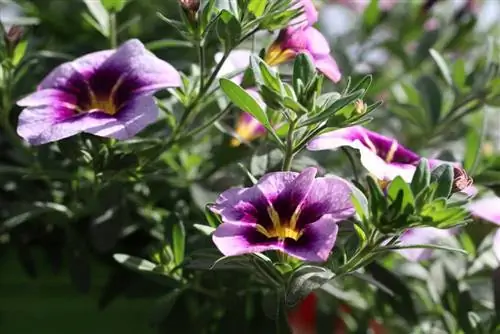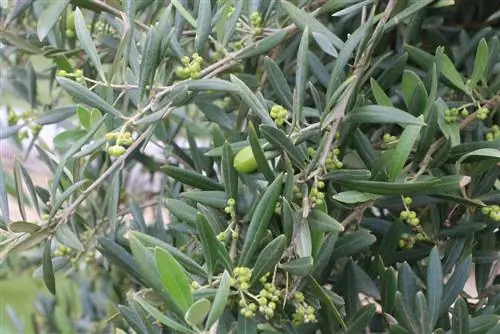- Author admin [email protected].
- Public 2023-12-17 03:39.
- Last modified 2025-01-24 12:45.
They leave traces of feeding, droppings, saliva, eggs, nests and, in the worst case, a sight of devastation in pots or beds. But by then it is usually far too late. Being able to recognize an infestation of plant pests in a timely manner and determine them is anything but useless knowledge. Especially if you hate using chemical weapons to combat the pests. Who is eating there? From snails to aphids, every pest leaves its own traces.
An overview of the most common plant pests, their appearance, their habits and their traces help to initiate the correct prevention and control strategies. The classification of the corresponding class and order in the animal and insect world can provide valuable information for counter-defense. Certain plants are susceptible to certain pests. There are plant pests that can hardly be seen with the naked eye. Then there is the vole, for example, which is relatively large and extremely active, but hidden. A snail rarely gets to the indoor palm and spider mites wreak havoc on spider plants and ficuses far away from the harsh nature.
The main suspects by size:
- Voles
- Snails
- Beetles/larvae
- Flying
- Lice
- Mites
Voles
The damage caused by voles can be significant. Some hobby gardeners only discover the damage when the plants die or the turf is completely destroyed. There are often doubts: were they moles or voles? A distinction is important because while the control of voles is permitted, the mole is a protected species. Mole hills may be visually disturbing to some people, while vole hills are rather small and inconspicuous. However, the damage caused by the latter is much greater.
Appearance
Voles, also called water voles, are somewhat similar to beavers. They have a rounded snout and, depending on the species, they can grow up to 24 cm tall. Their fur is light brown to dark brown. But what's the use of all the description, they do it in secret and you rarely see them. It is more important to identify them in good time based on their traces and damage.
Damage
Voles feed on juicy tubers, bulbs, rhizomes and roots underground. The damage to the plants can only be clearly determined late. Identifying characteristics of the vole are:
- The raised mounds of earth point in one direction (in contrast to a molehill). The burrows can often be seen on the surface. To be safe, just dig up a pile. If the hole goes along the side of the surface, it is a vole.
- The feeding damage to the plants themselves can only be seen late. They are easy to pull out of the ground or simply collapse.
Snails
A tiresome topic for every gardener, especially in rainy summers. The greatest damage is probably caused by the Spanish slugs, which attack young leaves in the garden in droves.
Appearance
The most widespread species of slug is the Spanish slug (Arion lusitanicus). It is so dangerous because we have plenty of food and hardly any natural enemies. The color of these snails, which vary in length, ranges from dark brown to light orange.
Damage
This snail is after almost anything that is fresh, young and green. You can see the enormous damage immediately. Plus, you usually catch them in the act.
Beetle
Most of the time it is the voracious larvae of the beetles that harm the plants. But some beetles also target the fresh greenery. In addition to Colorado potato beetles and click beetles, it is primarily species from the weevil family that can cause significant damage to the garden.
Otiorhynchus
The black weevils are among the weevils. The species of this beetle genus are around ten millimeters in size and are mostly black to brown in color, with lighter dots on a ridged surface. They are nocturnal and cannot fly. They use their biting tools to tamper with leaves, buds and young shoots. Their identifying features are:
- U-shaped damage to the leaf edges or needles
- Sudden wilting of plant parts or the whole plant
The larvae damage the roots of the plants with their food. It is therefore important to identify damage caused by the black weevil early enough so that it is best to take action against it in the larval stage. The finished beetles hatch in May and June. Controlling the larvae in March and April is therefore most effective.
Lice
Among the lice, aphids (Aphidoidea) are among the most widespread plant pests.
Aphids
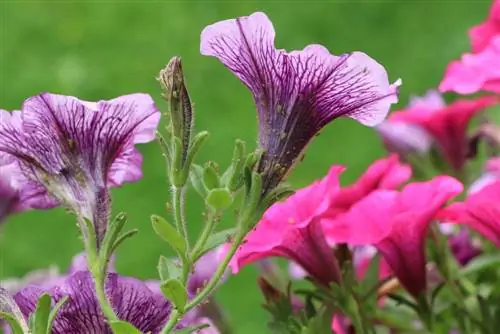
Aphids are a pest for both indoor and outdoor plants. In the garden, with proper plant care, they often come across their natural enemies, such as ladybirds. But even with houseplants, if you examine them regularly, you can quickly identify and combat them using the following characteristics and damage:
- They are 1 to 5 millimeters tall
- Green, black or gray
- Sits tightly packed at the tips of the shoots and on the undersides of the leaves
- Sticky plant parts
- Rolled and curled leaves
- Black coating on the leaves
Mites
Mites belong to the class of arachnids. The smallest of them are just 0.5 millimeters in size. The red spider (Panonychus ulmi) is widespread and causes great damage to plants.
Spider mites (Red Spider)
It is equally annoying for both indoor and outdoor plants. Especially if the plants grow under unfavorable conditions (over-fertilization, drought).
The spider mites are half a millimeter small. Mostly reddish or brown-yellow. They prefer to stick to the undersides of leaves. The damage:
- Leaves yellow and wilt
- Leaves with light speckles
- White webs on the leaves
Whitefly
The whitefly (Trialeurodes vaporariorum) is mainly found in rooms and greenhouses. It belongs to the whitefly family (Aleyrodidae) and is therefore not a fly. This quickly becomes clear when you take a closer look at the tiny flying insects:
- They are approximately 1.5 millimeters tall
- Wings lie like a roof over the small yellowish body
- Wings are white and have a wingspan of 5 millimeters
- Hind legs very pronounced
The white fly sucks on the leaves. If you go near the infected plant, they fly or jump up in all directions. An infestation of the plant can be recognized:
- Yellowed, wilted leaves
- Sticky plant parts
- Black fungal coating
Thrips
Thrips are also flighty and commonly encountered plant pests. Thrips belong to the flying insects of the order Thysanoptera. In heated rooms, they enjoy sucking on the leaves of houseplants and multiply rapidly. The thrips can be recognized by:
- elongated body up to 3 millimeters long
- sometimes with two pairs of wings (not very active in flight)
- black and white horizontal stripes on the wings
- Saw-like drill on the head
Due to their rapidly increasing population, they can be quite dangerous to houseplants. What makes it even more difficult is that they are difficult to spot because they are usually well camouflaged in the recesses of the leaf structures. They suck the juice from the underside of the leaves. The damage:
- Leaves appear silvery due to many small white dots
- Black feces spots on the undersides of the leaves
- Leaves dry up
Conclusion
The plant pests described here are so annoying and common because they do not specialize in particular plants. Most people like crunchy roots or fresh greens, almost regardless of the plant. If you know what the most common pests look like and recognize their damage early, you can usually prevent even greater damage to your plants. It is often worth taking a look at the order, class or family of the respective pests in order to be able to use this knowledge to seriously disrupt their reproductive and living habits.

